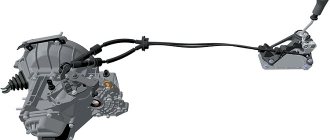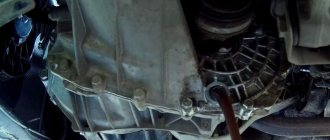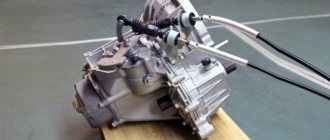Constant improvements in domestic cars allow modern drivers to purchase reliable vehicles at affordable prices. The updated Lada Granta with a robot is a model that is as close as possible to its foreign counterparts in terms of quality and ease of operation.
Attractive cost and the resulting characteristics create the optimal combination. Familiarization with the main advantages and features of the new box will help determine the need to purchase such a car.
Robotic checkpoint Grants: creation of development
AvtoVAZ craftsmen and engineers from the ZF plant took part in assembling the new box. The main task of the German developers was to create a common block - a basic switching map.
The connection of mechanisms and the adjustment of precise operation were carried out on the basis of standard Lada mechanics. The processing affected the box of the VAZ 2180, allowing it to be remade as a new product and add many useful and practical qualities.
Russian engineers were busy “grinding in” the parts to be able to normally operate the usual Granta using a robot. The work consisted of improving electronics to ensure correct signal delivery and processing.
At each stage of creation, checks were carried out to improve the results obtained. The main task was to adjust the interaction between the engine and gearbox. During the first run, accuracy rates were significantly lower than in the fully prepared production model.
The first tests took place at stands in Togliatti, after which the car was transported to domestic tracks, tracks in Italy and Germany. The tests carried out related to the operation of the box in different climatic conditions and with different loads.
As a result, the Lada Granta robot was noted by both Russian engineers and foreign developers as a reliable and practical car with the correct settings and well-coordinated operation of the engine and the new gearbox. The task was completely solved.
Pre-production tests
However, the Granta, equipped with an automated manual transmission, is now on the agenda; sales begin in February. To approach this date fully armed, a number of tests were carried out. One of the pre-production cars immediately went to Germany so that AvtoVAZ's partners from ZF, for their part, could conduct their own tests and allow the car to be put into production.
Starting with the Priora platform, cars have undergone a huge number of tests in various climatic zones and under a variety of programs. Tests took place in the Alps and Altai mountains with the participation of partners from Germany, at low temperatures reaching -55°C, in the Far North in Surgut. Speed tests were successfully carried out at the Porsche test site with humidity of almost 100 percent and temperatures exceeding +30°C. These tests were followed by accelerated road tests of 80,000 km and 100,000 km. Difficulties that arose during the testing process were resolved promptly, quickly and professionally.
The new gearbox is a product of Russian engineering, since the burden of solving most of the problems fell on VAZ’s shoulders. Engineers from Russia have demonstrated that their level is not inferior to the quality of engineers in the best European companies.
In general, the design of the new box consists of 80% Russian parts, and this says a lot.
Even during the period of joint work with the Germans on adapting the gearbox for the Priora, it was VAZ engineers who managed to quickly achieve smooth switching, which other companies cannot achieve for a long time. It is difficult in foreign boxes and with quick engagement - the transmission resource is insufficient.
An important advantage of the VAZ AMT is the ability of the system to adapt to the driver’s driving style - both calm and aggressive driving is possible. What else distinguishes the box from a traditional automatic transmission: at -40°C outside, the box makes it possible to start moving as soon as the engine is started. But fuel economy is, of course, the biggest plus.
Test drive Grants with a robot: race results
According to the control principle, the new gearbox is not inferior to the simplicity of automation. The movement begins by pressing the brake and moving the selector to neutral. This system allows you to secure the start of the car, thereby preventing errors when working with the new product. Driving a robotic Granta will be more familiar to previous owners of cars with an automatic transmission.
The conducted races were able to show how easy the model is to control: it accurately responds to switching, but exhibits a slight delay when starting. Short signal transmission is not critical.
For many motorists, this feature will not be a problem to purchase. But before purchasing, you need an independent test drive to evaluate the ease of operation.
The tests carried out by the developers themselves made it possible to evaluate the efficiency of the car. According to the race data, the average for city driving in manual mode is 6.1 liters per 100 km, and on the highway it drops to 5.1 liters.
Full automatic, suitable mainly for novice drivers, leads to different results: city consumption of 8.1 liters. Therefore, the use of manual switching is more beneficial for any owner of the updated Grant.
Experts, having carried out a test drive for the Lada Grant with a robot, noted the smooth running of the model itself. Unlike the performance of the robotic Priora, the Granta has greater attractiveness and accuracy.
Thanks to the updated frame and additions to the system, trips are made without problems. And the control is done softly: jerks during movement and long pauses when changing gears are eliminated.
Impressive result of good work
As a result, we can come to the conclusion that the VAZ team managed to create a good “robot”. What is especially impressive is that the project initially included unification, allowing the design to be quickly adapted to a number of models. The new AvtoVAZ product is in no way inferior to its analogues. From what is known, no unit with a “robot” has such elastic and smooth operation of the power unit.
Therefore, the “traditional” Jatco “automatic” has been replaced by a new product. This happened because VAZ’s “robot” is really quite good and is capable of satisfying the needs of the most demanding drivers. But the partnership with the Japanese continues, because it is necessary to give potential buyers maximum choice.
Today, cars equipped with automatic transmission and automatic transmission practically do not differ in price. But a price increase is coming for currently inexpensive Japanese-made automatic machines. After all, automatic transmissions are imported from Japan complete with a cooling system and require Japanese wheel drives. For AMT, everything was developed at AvtoVAZ. The only exceptions are actuators, control unit and selectors. The difference in price between a manual transmission and a “robot” is only 20,000 rubles. Jatco, even without taking into account drives and cooling, costs more than twice as much as a “robot”.
Advantages and disadvantages of Grants with a robotic box
An important nuance for buying a car with AMT is to compare the advantages and disadvantages. They are the ones who influence the buyer's decision. The Granta with the new box has quite a lot of advantages. The main advantages of AMT and its operation include:
1. Reduced amount of oil.
2. Complete absence of oscillation or vibration of the shift lever.
3. Availability of moisture-proof and dust-proof controllers, guaranteeing the reliability of the installation.
4. Simplicity and low cost of maintenance.
5. High-quality work in the temperature range from -40 to +50 degrees.
6. Minimum fuel consumption.
7. Simplified switching when driving in traffic jams.
The disadvantages of the new box include some delays when switching gears. The main disadvantage is climbing hills: in fully automatic mode there may be problems with the clutch opening. The problem can be solved by switching in manual mode.
An additional disadvantage is the reduced engine power, which can only be solved by flashing the system. But with such intervention, the owner is deprived of warranty obligations from the manufacturer.
Domestic and foreign competitors AMT Grants
The exterior of the improved Lada Granta robot is no different from its brothers in the shop with other gearboxes. The external design is laconic and solid, perfect for modern motorists.
The interior design is also the same, but on the front panel between the speedometer and tachometer, the robot has an engine temperature indicator. There is also a warning light that lights up when the driver makes incorrect actions and attempts to start the car without pressing the brake pedal.
The cost of the new model differs slightly from a car with automatic transmission. The difference is approximately 20 thousand rubles, so when choosing transport you should not focus solely on the price category. The difference with mechanics is also small. Therefore, almost all motorists can afford an improved model.
The main competitor among VAZ's developments for the Granta with a robot will be the Granta with a machine gun. The Japanese box has attracted the attention of many buyers and the reviews about it are very positive.
The significant difference between the two types is the ease of control: the automatic is smoother, more accurate and not so difficult to get used to. The robot attracts with its low fuel consumption, but can produce slight jerks when switching and puts a large load on the clutch in city driving conditions.
Among the foreign cars, there was also a competitor for the robotic Grant. Despite the love of drivers for the domestic automobile industry, the possibility of carrying out simple and inexpensive repairs, and the budget price, some buyers preferred the Japanese Datsun mi-DO.
The model's appearance is more attractive and coherent than Grant's. But repairing and maintaining such a car will require significant costs. Therefore, not all drivers will want to purchase a platform mate (the Datsun mi-DO based on Kalina is produced).
DSG 7 Features and typical faults
The seven-speed DSG 7 robotic gearbox appeared in 2006. It was developed for engines with a torque of 250 Nm. One of the features of the box is the need for a minimum amount when changing oil for maintenance. So, if DSG6 requires 6.4 liters of oil, then only two are enough for DSG 7. Today, tens of thousands of Audi, Volkswagen, Seat and Skoda cars are equipped with this particular gearbox. It is not distinguished by its reliability and wear resistance, but it gives pleasure from driving characteristics in tandem with a turbocharged engine. The majority of car owners use cars with this transmission and have no complaints. In general, the reviews about the dsg 7 are both positive and negative, in a ratio of 50 to 50. Some are not satisfied with its twitchiness, while others enjoy the speed of switching.
For what purposes is Granta with AMT suitable?
Buying a stylish car is worth it for drivers who live in small towns or usually make country trips.
Constantly changing gears and being stuck in traffic jams will negatively affect the condition of the clutch and the gearbox itself. Such phenomena will certainly lead to premature repairs. Intercity and interregional trips on such transport are pleasant and easy to make.
The Lada Granta with a robot is ideal for families who often travel by car. Purchasing a luxury version with a second airbag, climate control, 7-inch display and heated front seats will make traveling much easier.
Additions guarantee comfort and convenience. A special system for fixing child seats ensures reliable installation of a special seat for the baby.
Granta with AMT will also perform well as a representative car: its attractive appearance will help to impress employees or competitors. And at the same time, you need to think about the operating rules and wear and tear of the car that occurs when driving around the city.
In other cases, the buyer must make the decision independently. When purchasing a car with a robotic gearbox, a simple and careful ride is guaranteed. Those who want to travel quickly, without being distracted by long shifts, should pay attention to the analogue with a manual transmission.
Differences between AMT and other types of gearboxes
Unfortunately, there is no “preload” mode, which is available in conventional automatic transmissions, when the car starts to move from idle.
There is no way to overcome small hills by releasing the gas pedal - a car with a robotic transmission must in such situations put on the handbrake or apply gas. During the development of the transmission, foreign analogues equipped with a recoil mode were studied. As a result, we decided not to include this feature in our robotic transmission, since the electronics only notice a steep climb, and a small hill for a momentarily distracted driver can cause a rollback and, in urban conditions, cause an accident. The same danger comes from releasing the brake on a car equipped with a classic automatic transmission with “drive” turned on. At first, the robotic transmission requires the driver to get used to and control his actions. You need to be especially careful in urban environments that require frequent difficult operations: starting, making a U-turn, turning off the engine, parking. But all the required actions are intuitive and logical, so getting used to the new product happens very quickly. By the way, both CVTs and conventional automatic transmissions need to adapt to them. It is much more difficult for a beginner to get used to ordinary mechanics.
The undoubted advantage of the robotic version of the device is the complete elimination of errors and breakdowns caused by subjective factors. At the same time, it will not be possible to engage the wrong gear, for example, reverse while moving forward, in such a gearbox. In addition, the “robot” makes it possible to control the temperature in the gearbox. A special lamp signals critical overheating. This option is not available in either manual or automatic transmissions.
Users of automatic transmissions notice the moments when gears are changed in AMT. Indeed, in the Japanese automatic transmission Jatco, gear shifting occurs very smoothly without obvious power breaks, and the “robot” needs a short time to change speed. AMT is a relatively simple design: in a classic VAZ gearbox, shifting is controlled by two ZF actuators - German-made electrical actuators. One of them helps the driver to depress the clutch, and the second is responsible for engaging a specific gear.











